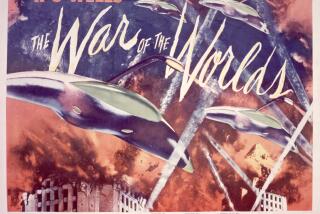Martian mayhem
- Share via
Mars has been much in the popular eye recently with the continuing exploits of the Martian Rovers and President Bush’s call last year for a manned mission to the Red Planet. Science-fiction novels set on or around Mars abound, and Kim Stanley Robinson’s chromatic trilogy, “Red Mars,” “Green Mars” and “Blue Mars,” eventually may grace the small screen. The big Martian news on this, the 107th anniversary of the first publication of H.G. Wells’ novel “The War of the Worlds,” is the new Steven Spielberg film version starring Tom Cruise.
Although the novel has stayed in print since its first publication in 1898, a handful of new editions have been timed to the film’s release. Patrick Parrinder of Britain’s University of Reading has put together a lovely edition for Penguin Classics in which science-fiction luminary Brian Aldiss provides a broad-ranging introduction to Wells’ life and the novel and University of Liverpool librarian and scholar Andy Sawyer supplies textual notes. But “The War of the Worlds” is first and foremost an action novel, a precursor to the popular disaster genre. Wells’ Everyman narrator is an eyewitness to Martian ships landing and their one-sided engagements with humans. The military and the government are overwhelmed by the speed and brutality of the invaders. In chapters that do not seem dated in the least, Wells describes the rout of London and the horrors suffered by the terrified fleeing masses. The suspenseful novel is intensely visual, and over the years, innumerable artists have illustrated it. Edward Gorey’s wonderful 1960 pen-and-ink illustrations can be seen again in the elegant new hardcover edition from New York Review Books.
Another tie-in published to take advantage of the film’s publicity machine is Kevin J. Anderson’s pastiche, “The Martian War” (written under the pseudonym Gabriel Mesta for Pocket Books). Billed as a “thrilling eyewitness account,” it is best quickly passed over. Instead, try Alan Moore and Kevin O’Neill’s second “The League of Extraordinary Gentlemen” graphic novel. This DC Comics series, infinitely darker, smarter and more intriguing than the film based on the first volume, is useful in comparing Wells’ time with our own. “The League” features some futurist technology, but “The War of the Worlds” was published in a world without such necessities as radio, television, manned flight, mass-produced cars, cornflakes, crayons, Band-Aids and refrigerators. Moore and O’Neill deftly weave together Wells’ novel, Edgar Rice Burroughs’ Mars stories and more in a tale of betrayal, as fictional heroes -- Allan Quartermain, Captain Nemo, Hawley Griffin (the Invisible Man), Edward Hyde and Mina Murray -- defend England from a Martian invasion.
The most famous adaptation is Orson Welles’ panic-inspiring radio play. There was producer George Pal’s 1953 film (in which Martians invade Los Angeles) and a 1980s TV series. Like the 1938 radio drama, Spielberg’s film uses New Jersey as the simulacrum for Wells’ London suburb, Woking. Whether it still will be watched in 100 years remains to be seen. But Wells’ novel will still be read. *
More to Read
Sign up for our Book Club newsletter
Get the latest news, events and more from the Los Angeles Times Book Club, and help us get L.A. reading and talking.
You may occasionally receive promotional content from the Los Angeles Times.









